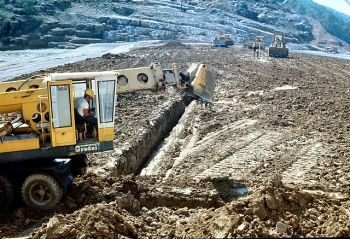Construction: Difference between revisions
Rmanwaring (talk | contribs) No edit summary |
No edit summary |
||
| Line 12: | Line 12: | ||
<!-- Delete any sections that are not necessary to your topic. Add pictures/sections as needed --> | <!-- Delete any sections that are not necessary to your topic. Add pictures/sections as needed --> | ||
"Some of the potential problems that could occur during construction can be reduced by clear, concise specifications and clear, concise instructions to contract administration personnel regarding design assumptions and reasons for design requirements. This information is usually conveyed in the [[Construction Considerations|construction considerations]] document that is prepared by the design staff for the construction staff. Because most of this information is also valuable to the contractor, the current policy is to include construction considerations and the basis for various assumptions in applicable sections of the specifications. For example, geologic and [[engineering]] reasons for specifying excavation to particular surfaces for the foundation of the dam should be included in the specification section on foundation excavation. Confidence in the information on which the requirements are based should also be conveyed in the specifications. When this type of information is provided in the applicable technical paragraphs of the specifications, it gives prospective bidders a clearer, more informed basis for preparing their bid and, therefore, a better opportunity for a more responsive bid, which results in less likelihood that claim situations will develop. It also minimizes the possibility that the contractor will deny lack of knowledge of information that was essential to preparation of the bid."<ref name="DS13-10">[[Design Standards No. 13: Embankment Dams (Ch. 10: Embankment Construction) | Design Standards No. 13: Embankment Dams (Ch. 10: Embankment Construction), USBR, 2012]]</ref> | "Some of the potential problems that could occur during construction can be reduced by clear, concise specifications and clear, concise instructions to contract administration personnel regarding design assumptions and reasons for design requirements. This information is usually conveyed in the [[Construction Considerations|construction considerations]] document that is prepared by the design staff for the construction staff. Because most of this information is also valuable to the contractor, the current policy is to include [[Construction Considerations|construction considerations]] and the basis for various assumptions in applicable sections of the specifications. For example, geologic and [[engineering]] reasons for specifying excavation to particular surfaces for the foundation of the dam should be included in the specification section on foundation excavation. Confidence in the information on which the requirements are based should also be conveyed in the specifications. When this type of information is provided in the applicable technical paragraphs of the specifications, it gives prospective bidders a clearer, more informed basis for preparing their bid and, therefore, a better opportunity for a more responsive bid, which results in less likelihood that claim situations will develop. It also minimizes the possibility that the contractor will deny lack of knowledge of information that was essential to preparation of the bid."<ref name="DS13-10">[[Design Standards No. 13: Embankment Dams (Ch. 10: Embankment Construction) | Design Standards No. 13: Embankment Dams (Ch. 10: Embankment Construction), USBR, 2012]]</ref> | ||
==Roles and Responsibilities== | ==Roles and Responsibilities== | ||
| Line 25: | Line 25: | ||
* [[Dewatering]] | * [[Dewatering]] | ||
* [[Geotechnical Exploration]] | * [[Geotechnical Exploration]] | ||
* [[Support of Excavation]] | |||
* [[Construction Considerations|Outlet Works Construction]] | * [[Construction Considerations|Outlet Works Construction]] | ||
Revision as of 22:16, 15 December 2022

|
| Construction of an embankment dam. |
"Some of the potential problems that could occur during construction can be reduced by clear, concise specifications and clear, concise instructions to contract administration personnel regarding design assumptions and reasons for design requirements. This information is usually conveyed in the construction considerations document that is prepared by the design staff for the construction staff. Because most of this information is also valuable to the contractor, the current policy is to include construction considerations and the basis for various assumptions in applicable sections of the specifications. For example, geologic and engineering reasons for specifying excavation to particular surfaces for the foundation of the dam should be included in the specification section on foundation excavation. Confidence in the information on which the requirements are based should also be conveyed in the specifications. When this type of information is provided in the applicable technical paragraphs of the specifications, it gives prospective bidders a clearer, more informed basis for preparing their bid and, therefore, a better opportunity for a more responsive bid, which results in less likelihood that claim situations will develop. It also minimizes the possibility that the contractor will deny lack of knowledge of information that was essential to preparation of the bid."[1]
Roles and Responsibilities
Types of Construction Activities
- First Filling
- Care and Diversion of Water
- Dewatering
- Geotechnical Exploration
- Support of Excavation
- Outlet Works Construction
Construction Management Services
Citations:
Revision ID: 5778
Revision Date: 12/15/2022
